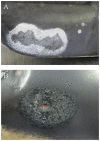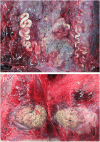Pathological Findings in White-Beaked Dolphins (Lagenorhynchus albirostris) and Atlantic White-Sided Dolphins (Lagenorhynchus acutus) From the South-Eastern North Sea
- PMID: 32671103
- PMCID: PMC7326107
- DOI: 10.3389/fvets.2020.00262
Pathological Findings in White-Beaked Dolphins (Lagenorhynchus albirostris) and Atlantic White-Sided Dolphins (Lagenorhynchus acutus) From the South-Eastern North Sea
Abstract
In the North Sea, white-beaked dolphins (Lagenorhynchus albirostris) occur regularly and are the second most common cetacean in the area, while their close relative, the Atlantic white-sided dolphin (Lagenorhynchus acutus), prefers the deeper waters of the northern North Sea and adjacent Atlantic Ocean. Though strandings of both species have occurred regularly in the past three decades, they have decreased in the southern North Sea during the last years. Studies describing necropsy findings in stranded Lagenorhynchus spp. are, to date, still scarce, while information gained through post-mortem examinations may reveal valuable information about underlying causes of this decline, including age structure and the reproduction status. Therefore, we retrospectively assessed and compared the necropsy results from fresh Lagenorhynchus spp. stranded along the southeastern North Sea between 1990 and 2019. A full necropsy was performed on 24 white-beaked dolphins and three Atlantic white-sided dolphins from the German and Dutch coast. Samples of selected organs were taken for histopathological, bacteriological, mycological, parasitological and virological examinations. The most common post-mortem findings were emaciation, gastritis and pneumonia. Gastritis and ulceration of the stomach was often associated with an anisakid nematode infection. Pneumonia was most likely caused by bacterial infections. Encephalitis was observed in three animals and morbillivirus antigen was detected immunohistochemically in one case. Although the animal also showed pneumonic lesions, virus antigen was only found in the brain. Parasitic infections mainly affected the gastro-intestinal tract. Lungworm infections were only detected in two cases and no associations with pathological alterations were observed. Stenurus spp. were identified in two of three cases of parasitic infections of the ears. Twelve of the 26 white-beaked dolphins stranded in Germany were found between 1993 and 1994, but there was no evidence of epizootic disease events or mass strandings during the monitored period.
Keywords: Germany; Lagenorhynchus acutus; Lagenorhynchus albirostris; North Sea; The Netherlands; pathology.
Copyright © 2020 Schick, IJsseldijk, Grilo, Lakemeyer, Lehnert, Wohlsein, Ewers, Prenger-Berninghoff, Baumgärtner, Gröne, Kik and Siebert.
Figures







Similar articles
-
Is dolphin morbillivirus virulent for white-beaked dolphins (Lagenorhynchus albirostris)?Vet Pathol. 2014 Nov;51(6):1174-82. doi: 10.1177/0300985813516643. Epub 2014 Jan 7. Vet Pathol. 2014. PMID: 24399208
-
Helicobacter cetorum infection in striped dolphin (Stenella coeruleoalba), Atlantic white-sided dolphin (Lagenorhynchus acutus), and short-beaked common dolphin (Delphinus delphus) from the southwest coast of England.J Wildl Dis. 2014 Jul;50(3):431-7. doi: 10.7589/2013-02-047. Epub 2014 May 7. J Wildl Dis. 2014. PMID: 24807181
-
A genomewide catalogue of single nucleotide polymorphisms in white-beaked and Atlantic white-sided dolphins.Mol Ecol Resour. 2016 Jan;16(1):266-76. doi: 10.1111/1755-0998.12427. Epub 2015 May 29. Mol Ecol Resour. 2016. PMID: 25950249
-
The Rough-Toothed Dolphin, Steno bredanensis, in the Eastern Mediterranean Sea: A Relict Population?Adv Mar Biol. 2016;75:233-258. doi: 10.1016/bs.amb.2016.07.005. Epub 2016 Sep 7. Adv Mar Biol. 2016. PMID: 27770986 Review.
-
A review of the 1988 European seal morbillivirus epizootic.Vet Rec. 1990 Dec 8;127(23):563-7. Vet Rec. 1990. PMID: 2288059 Review.
Cited by
-
Population genomics of the white-beaked dolphin (Lagenorhynchus albirostris): Implications for conservation amid climate-driven range shifts.Heredity (Edinb). 2024 Apr;132(4):192-201. doi: 10.1038/s41437-024-00672-7. Epub 2024 Feb 1. Heredity (Edinb). 2024. PMID: 38302666 Free PMC article.
-
A systematic review on global zoonotic virus-associated mortality events in marine mammals.One Health. 2024 Aug 4;19:100872. doi: 10.1016/j.onehlt.2024.100872. eCollection 2024 Dec. One Health. 2024. PMID: 39206255 Free PMC article. Review.
References
-
- Kinze CC. White-beaked dolphin: Lagenorhynchus albirostris. In: Perrin WF, Wursig B, Thewissen JGM. editors. Encyclopedia of Marine Mammals. San Diego, CA: Academic Press; (2009). p. 1255–8. 10.1016/B978-0-12-373553-9.00285-6 - DOI
-
- Canning SJ, Santos MB, Reid RJ, Evans PG, Sabin RC, Bailey N, et al. Seasonal distribution of white-beaked dolphins (Lagenorhynchus Albirostris) in UK waters with new information on diet and habitat use. J Marine Biol Assoc UK. (2008) 88:1159–66. 10.1017/S0025315408000076 - DOI
-
- Galatius A, Jansen OE, Kinze CC. Parameters of growth and reproduction of white-beaked dolphins (Lagenorhynchus Albirostris) from the North Sea. Mar Mamm Sci. (2013) 29:348–55. 10.1111/j.1748-7692.2012.00568.x - DOI
-
- Shirihai H, Jarrett B. Weißschnauzendelfin. In: Shirihai H, Jarrett B, editors. Meeressäuger. Berlin: Kosmos; (2008). p. 199–200.
-
- Jansen OE, Leopold MF, Meesters EH, Smeenk C. Are white-beaked dolphins Lagenorhynchus Albirostris food specialists? their diet in the southern North Sea. J Marine Biol Assoc UK. (2010) 90:1501–8. 10.1017/S0025315410001190 - DOI
LinkOut - more resources
Full Text Sources
Miscellaneous

